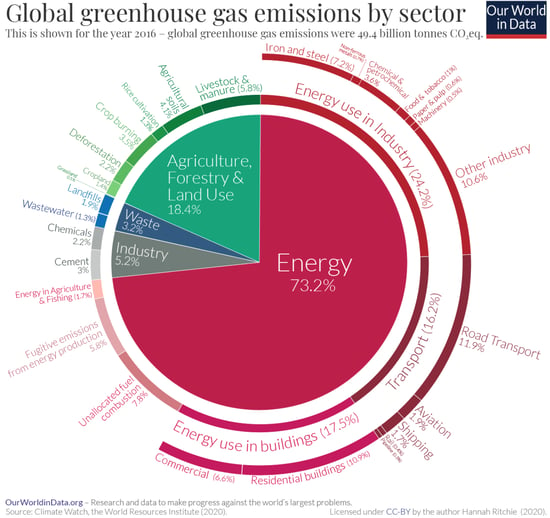The growing carbon footprint of digitalization and how to control it

Everything that we do impacts the environment. It’s especially true if you’re looking at the actions of a company. When we think of the emissions by industry or sectors used in business operations, we tend to see the digital as “cleaner” than its traditional analog counterpart. But while sending a presentation through a file hosting service may not create the same emissions as professionally printing and sending it through a physical delivery service, there’s still a CO2 footprint.
The backbone behind our 21st century digital world and the entire tech industry, the data storage necessary for the on-demand availability of digital resources and applications are growing and creating a massive amount of emissions requires a massive amount of energy.
How digital services create CO2 emissions
From instant communication and file storage to online content and video conferencing, digital services have become a major part of our day-to-day and long term operations. Even many software applications that users once had to install on their own hard drives are now offered as services delivered over the internet.
Accessing any digital service requires a lot of electricity. Not just by the computers or smartphones that are using it (whether they’re plugged-in or charged) or the communication networks that send the data back and forth, but also by the servers that store its data. They have to remain running to some degree or another. There are data centers that are essentially warehouses of up to 40,000 square meters and filled with servers, running and consuming power all across the world. And while renewable energy is on the rise, a large portion of electricity is still generated through fossil fuels, like power plants that burn coal. It’s estimated that 30% of data centers run on a 24/7 basis, often resulting in energy wastage of around 5-10% of their full capacity.
To put all that into perspective, the researchers behind a recent article in the journal Resources, Conservation & Recycling calculated that one hour of videoconferencing can emit up to 157 grams of carbon. They also calculated that if a person with 15 hours worth of meetings a week were to turn off the video and use audio only for one month, their monthly carbon footprint would drop by just over 9 kilograms, equivalent to charging a smartphone every night for over three years.
Where does digitization fit when calculating emissions by scope? For an organization that uses outside digital services, like video conferencing or website hosting, they would be classified as scope 3 emissions. But a tech company that operates digital services for its own use, like keeping servers in an in-house data center, or that offers such services as part of their business model, they would be considered scope 2 emissions.
The CO2 footprint of tech is rising in comparison to emissions by industry
There are many different estimates on how much of all greenhouse gases are the result of digitalization. Conservatively, the percentage of global emissions created by the information technology used to manage and maintain digital services can be put between 2 and 3%. And it’s pushing the tech industry to the point of overtaking other historically pollutant industries when compared to the emissions of other industries.
Emissions by sector: Our World in Data
Sectors and industries that tech is now exceeding in emissions:
- Aviation: The CO2 footprint of the tech industry now exceeds the emission levels seen within the aviation industry, pre-pandemic. Historically viewed as one of the world’s biggest emitters, flights around the world have been previously recorded as making up 1.9% of all global emissions.
- Shipping: The tech industry’s emissions as the result of digitalization now surpass the emissions of the shipping industry, which is estimated to be 1.7% due to its reliance on sulfur, as well as emissions from the burning of petrol or diesel on boats. This includes both passenger and freight maritime trips.
- Landfills: The sector of waste management that uses sites for the dumping of waste material creates a massive amount of methane due to the decomposition of organic material. And comprising 1.9% of all emissions, it now trails behind tech.
The emissions caused by the power consumption of digital services can also arguably match or slightly exceed the global emissions of notoriously dirty activities, like:
- Deforestation: Although removing tree forests for converting the land significantly affects emissions through the lost and altered carbon stores from forests and soils, the net emissions are lowered by reforestation practices. The remaining emissions are estimated at 2.2%, which is at the lower end of the range for the tech industry’s emissions.
- Chemicals & petrochemicals industrial process: Taking into account the emissions of industrial sectors that are not caused by energy consumption and are just greenhouse gases produced as a byproduct from chemical processes, like the production of ingredients for cleaning products or the manufacturing of fertilizer and pesticides, the estimate is also 2.2%.
The emissions resulting from digital services and the CO2 footprint of the tech industry are only expected to increase. Society and the business world were already growing more digital, but the COVID-19 pandemic seems to have boosted its acceleration. Spending on IT infrastructure, both public and private, rose by a staggering 34.4% from 2019 to the end of 2020.
But unlike other sectors of industries that drive up emissions, digital services also hold the key for lowering tech’s CO2 footprint.
How to lower digitalization’s CO2 footprint
It’s important to remember that many digital services, while increasing emissions from energy consumption, also replace activities that could easily be argued created more, if not the same amount of CO2. So, using a non-digital equivalent isn’t a practical solution.
Companies that create digital services can utilize different methods to lower the carbon footprint of their infrastructure. Facebook, for example, moved part of its IT infrastructure to northern Sweden, where the cold location reduces the amount of energy needed to keep servers from overheating. Others, like Amazon, use carbon offsets, in which they pay someone else to cut or remove a quantity of greenhouse gases that matches the amount of the emissions caused by their data centers.
Switching to cloud-based solutions from onsite data centers is a way many small to midsize companies curb their emissions. Most cloud data centers operate on a much more energy-efficient level. A 2019 article by the technology research and advisory firm ISG cited research that cloud computing could reduce the industry’s emission by 28% in five years.
But the main way to lower emissions created by digital services is to power them through climate-friendly providers. Organizations that use cloud-based solutions can pick service providers that use renewable energy, offsets, or both. At the same time, companies that maintain onsite data centers can request similar options from their energy providers.
The current hyper-expansion of digital services places the tech industry and those that rely on them in a unique position. And while business decisions aren’t always built on environmental concerns alone, understanding that digitalization comes with a price is the first step to lowering emissions and tech’s CO2 footprint.
If you want to learn about how to minimize and control your organization’s carbon footprint, watch our on-demand webinar on the subject. Our sustainability experts are always happy to help you reach your sustainability targets, and to guide you to minimize your GHG emissions.Worldfavor’s Supply Chain Visibility solution enables you to map out every tier of your supply chain through crowd-sourced data and get hands on hard-to-reach information from suppliers and sub-suppliers. Regardless if you’re complying with Germany’s new legislation, or just preparing for similar EU laws to come – with Worldfavor, you will take control over your entire supply chain, uncover vulnerabilities and build resilience. Sounds interesting? Let our supply chain experts tell you more!
Related blogs you might like:








%20as%20the%20deadline%20approaches.%20Learn%20about%20compliance%20requirements%2c%20potential%20delays%2c%20and%20key%20updates..png)

